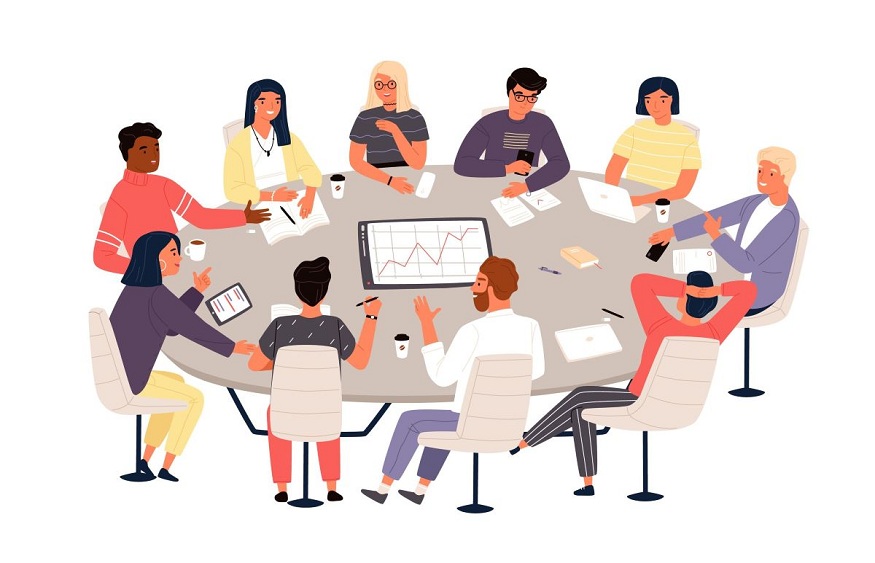Employee Resource Groups (ERGs) have become an integral part of promoting diversity, equity, and inclusion within the modern workplace. Also known as affinity groups or business network groups, ERGs are employee-led groups that unite employees with shared interests, backgrounds, or demographic characteristics.
From Fortune 500 corporations to small businesses, ERGs help employees find community, foster inclusion, and drive positive change within organizations.
This comprehensive guide will explore the benefits of ERGs, provide best practices for creating effective groups, and share actionable tips for maximizing their impact within your organization.
What are Employee Resource Groups?
Employee Resource Groups (ERGs) are voluntary, employee-led groups that bring together employees with common identities, experiences, or interests. While ERGs can form around any shared interests, some of the most common types include:
- Gender or gender identity (women, LGBTQ+)
- Race or ethnicity
- Ability or disability
- Religion or faith
- Working parents
- Veterans
- Multicultural backgrounds
ERGs provide members with tailored professional development, networking opportunities, mentorship, and venues to discuss common experiences as minorities within their workplace. Groups are often organized around providing support, enhancing career growth, and helping members network across the company.
Though ERGs have existed for decades, they first gained prominence in 1970 when the CEO of Xerox officially supported the creation of the National Black Employees Caucus. This groundbreaking ERG gave black employees an organized voice to advocate for advancement and change within the company.
Today, over 90% of Fortune 500 companies have ERGs, highlighting their evolution into a standard component of diversity and inclusion programs.
A Brief History of ERGs
ERGs emerged out of a desire for underrepresented groups to find community and belonging in the workplace. They have their origins in race-based employee groups that began organizing in the 1960s during the Civil Rights Movement.
The first official ERG is considered to be the National Black Employees Caucus, formed at Xerox in 1970. Under the leadership of CEO Joseph Wilson, the caucus was created to support black employees and advocate for change within Xerox. This demonstrated the importance of executive sponsorship in establishing and empowering ERGs.
Since then, ERGs have become more widespread, with over 90% of Fortune 500 companies having at least one ERG. They now serve a broader purpose of fostering inclusion, equity, professional development, and cultural awareness.
The Benefits of ERGs
While ERGs center around supporting minority employees, they provide significant benefits for all employees as well as the company as a whole.
For Employees
- Fosters inclusion and belonging – ERGs help employees from underrepresented groups feel welcomed, included, and valued within the company. Employees get to connect with similar coworkers in an affirming space.
- Community building – ERGs facilitate relationship building and create a sense of community. Members gain social and professional connections across the company.
- Career development – ERGs create leadership opportunities and exposure to executives that can accelerate members’ careers. Mentorship programs also foster skill development.
- Support system – Members can share concerns, experiences, and strategies for navigating the workplace as a minority. It provides a built-in support network.
For Organizations
- Recruitment and retention – ERGs signal a company’s commitment to diversity and inclusion. This helps attract and retain diverse talent.
- Professional development – ERGs build leadership, communication, and collaboration skills through organizing group events and initiatives.
- Cultural competence – ERGs educate coworkers and leadership about diverse groups’ needs and perspectives.
- Community engagement – ERGs often participate in outreach, volunteering, and social initiatives. This strengthens the company’s community presence.
- Innovation – By bringing together diverse voices and viewpoints, ERGs spur creative thinking and problem-solving.
Clearly, well-run ERGs benefit employees and companies alike. They signal an inclusive culture that values all backgrounds.
Creating Effective ERGs: Best Practices
While any group of passionate employees can form an ERG, certain best practices will maximize an ERG’s impact and effectiveness.
Secure Executive Support
Gaining buy-in from senior leadership is crucial. Executives can provide funding, direction, and visibility for ERGs across the company. Identify an executive sponsor who’ll actively promote the ERG and keep leadership informed.
Define Structure and Purpose
Outline the ERG’s specific mission, goals, focus areas, and membership criteria at the outset. Establish leadership roles and responsibilities. Update the charter as the group evolves.
Foster Cross-Department Participation
Don’t silo the ERG within one department. Welcome interested employees from all business units, levels, and locations. The diversity of members will enrich discussions.
Provide Budget and Resources
ERGs need funding for events, materials, and initiatives. Negotiate an annual budget with leadership sponsors. Give ERGs access to internal communication channels and meeting spaces.
Offer Mentorship Programs
Facilitate mentor relationships between ERG members and organizational leaders. Mentorship enables professional development and relationships across the company.
Host Engaging Programming
Host speakers, panels, workshops, community service projects, and social events that align with the ERG’s purpose. Creative programming will attract members and keep them engaged.
Track Member Participation
Measure ERG event attendance, membership numbers, participation levels, and demographics. Tracking metrics helps gauge engagement and demonstrates the ERG’s impact.
Collaborate With Other ERGs
Building partnerships between ERGs amplifies reach and avoids duplicating efforts. Brainstorm event partnerships or joint campaigns on shared interests.
Promote Accomplishments
Ensure the entire company knows about the ERG’s work by publicizing initiatives through internal PR. Recognition from leadership incentivizes participation.
By following these best practices, companies can empower ERGs to fully support members while advancing diversity and inclusion.
Examples of Successful ERGs
Some noteworthy examples of successful and impactful employee resource groups include:
- Avison Young, a commercial real estate firm, formed an ERG for women, which implemented a mentorship program pairing women in the ERG with company leaders. This helped increase female representation in leadership roles to 40%.
- The video game company King Games launched an ERG and mentorship program focused on supporting its non-male employees. After launching the program, they increased new female hires from 1/3 to 40% of new hires.
- Insurance company New York Life created an “Empower Program,” connecting ERG members with organizational leaders in a reverse-mentoring Over 50% of ERG members were paired with senior mentors.
These examples demonstrate the power of ERGs in building community and driving real demographic change within companies. The strategic use of mentorship takes these ERGs to the next level of impact.
The Role of ERGs in Fostering Inclusion
While often started organically by employees, successful ERGs require cultivation and strategic support from company leadership. ERGs play an integral role in an organization’s overall equity, diversity, and inclusion efforts across all areas:
- Talent acquisition: Share first-hand experiences to help attract diverse candidates.
- Onboarding: Welcome new hires from similar backgrounds, making them feel included from day one.
- Development: Provide mentorship and growth opportunities for ERG members.
- Succession planning: Identify high-potential future leaders from within ERGs.
- Workforce planning: Offer insights from the employee perspective to inform strategic decisions.
Effective ERGs require executive allies and sponsors to provide the infrastructure, resources, and visibility needed to drive meaningful impact.
Fostering Belonging Through ERGs
At their core, ERGs foster a greater sense of belonging among employees. They create meaningful connections, community, and advocacy for underrepresented groups.
While ERGs should not be solely responsible for an organization’s diversity, equity, and inclusion efforts, they remain an important grassroots initiative. When supported, developed, and integrated strategically, ERGs enable employees of all backgrounds to feel welcomed, valued and heard. This cultivates an engaging and inclusive workplace where everyone can contribute to their full potential.
Fostering an Inclusive Culture Through ERGs
Far from being mere social clubs, today’s evolved ERGs play a strategic role in building diverse talent pipelines, fostering inclusion, and driving business results. By providing vital support and community for minority employees, ERGs enable companies to live their diversity and inclusion values.
The Norfus Firm partners with organizations to develop effective, strategic diversity, equity, and inclusion programs that drive measurable results. Their team can help you assess your current ERGs or launch impactful new groups aligned with your inclusion goals and company culture. Contact them today for more information.




